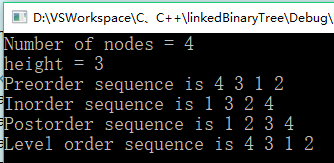一、二叉树的常用操作
- 确定高度
- 确定元素数目
- 复制
- 显示或打印二叉树
- 确定两棵二叉树是否一样
- 删除整棵树
二、二叉树抽象数据类型(ADT)

三、二叉树的抽象类(binaryTree)
template<class T>
class binaryTree
{
public:
virtual ~binaryTree() = 0;
virtual bool empty()const = 0; //二叉树是否为空
virtual int size()const = 0; //二叉树大小
virtual void preOrder(void(*)(T*)) = 0; //前序遍历二叉树
virtual void inOrder(void(*)(T*)) = 0; //中序遍历二叉树
virtual void postPOrder(void(*)(T*)) = 0; //后续遍历二叉树
virtual void levelOrder(void(*)(T*)) = 0; //层数遍历二叉树
};
四、编码实现
头文件定义
#include <iostream>
#include <string>
#include <sstream>
#include <algorithm>
#include <functional>
#include <queue>
#include <exception>
#include <stdexcept>
using std::cout;
using std::cin;
using std::endl;
using std::string;
using std::max;
using std::pair;
using std::function;
using std::queue;
异常类定义
class treeEmpty
{
public:
treeEmpty(const char* theMessage = "The tree is empty") :message(theMessage) {
}
const char* what() { return this->message.c_str(); }
private:
std::string message;
};
二叉树节点(binaryTreeNode)
template<typename T>
struct binaryTreeNode
{
T element; //节点元素
struct binaryTreeNode<T>* leftChild, *rightChild; //节点的左孩子和右孩子指针
//以下为3种构造函数
binaryTreeNode() {
this->leftChild = this->rightChild = nullptr;
}
binaryTreeNode(const T& theElement) :element(theElement) {
this->leftChild = this->rightChild = nullptr;
}
binaryTreeNode(const T& theElement,struct binaryTreeNode<T>* theLeftChild,struct binaryTreeNode<T>* theRightChild) :element(theElement) {
this->leftChild = theLeftChild;
this->rightChild = theRightChild;
}
};
二叉树抽象类(binaryTree)
template<typename T>
class binaryTree
{
public:
virtual ~binaryTree() {}
virtual bool empty()const = 0; //二叉树是否为空
virtual int size()const = 0; //二叉树大小
virtual void preOrder(void(*)(T*)) = 0; //前序遍历二叉树
virtual void inOrder(void(*)(T*)) = 0; //中序遍历二叉树
virtual void postOrder(void(*)(T*)) = 0; //后续遍历二叉树
virtual void levelOrder(void(*)(T*)) = 0; //层数遍历二叉树
};
二叉树的链表实现(linkedBinaryTree)
构造函数、析构函数、清除函数(erase())、删除节点函数(++dispose())
- 构造函数将根节点置空,树的大小置位0
- 析构函数直接调用erase清除函数
- erase()函数:清除函数利用后续遍历(后续遍历见下)整个树的每个节点,然后在每个节点上调用__dispose()函数
- __dispose()函数:传入一个节点,删除该节点
template<typename T>
class linkedBinaryTree :public binaryTree<binaryTreeNode<T>>
{
public:
linkedBinaryTree() {
this->root = nullptr;
this->treeSize = 0;
}
~linkedBinaryTree() { erase(); } //析构函数,直接调用erase成员函数
//清空整个数(后序遍历整个树,并且每个节点执行__dispose函数)
void erase() {
this->postOrder(this->__dispose);
this->root = NULL;
this->treeSize = 0;
}
protected:
binaryTreeNode<T>* root; //根节点
int treeSize; //树的节点个数
static void(*__visit)(binaryTreeNode<T>* theNode);//一个函数指针,参数是一个binaryTreeNode类型
protected:
static void __dispose(binaryTreeNode<T>* theNode) { delete theNode; theNode = NULL; } //释放参数所指的节点
};
__visit函数指针
- 一个函数指针,参数是一个节点,将一个特定类型的函数赋值给该指针时,用来对参数所指的节点进行删除/遍历
判断是否为空(empty())、返回树大小(size())、返回根节点(rootNode())
- empty():判断树是否为空
- size():返回树的大小
- rootNode():返回根节点
template<typename T>
class linkedBinaryTree :public binaryTree<binaryTreeNode<T>>
{
public:
bool empty()const { return (this->treeSize == 0); } //判断树是否为空
int size()const { return this->treeSize; } //返回树的大小
binaryTreeNode<T>* rootNode()const { return ((this->treeSize == 0) ? NULL : this->root;) }//返回根节点
};
返回树的高度(height()、__height())
- height():返回树的高度,直接调用__height()函数
template<typename T>
class linkedBinaryTree :public binaryTree<binaryTreeNode<T>>
{
public:
int height()const { return __height(this->root); } //返回树的高度
protected:
static int __height(binaryTreeNode<T>* theNode); //返回树的高度
};
//返回树的高度(递归)
template<typename T>
int linkedBinaryTree<T>::__height(binaryTreeNode<T>* theNode)
{
if (theNode == nullptr)
return 0;
int leftSize = __height(theNode->leftChild); //递归左子树的高度
int rightSize = __height(theNode->rightChild);//递归右子树的高度
//返回最大的高度(++是因为需要加上根节点)
return (std::max(leftSize, rightSize) + 1);
}
构造树函数(makeTree)
- 此函数用来初始化一棵树,在下面main函数使用时介绍
template<typename T>
void linkedBinaryTree<T>::makeTree(const T& element,linkedBinaryTree<T>& left, linkedBinaryTree<T>& right)
{
this->root = new binaryTreeNode<T>(element, left.root, right.root);
this->treeSize = left.treeSize + right.treeSize + 1;
left.root = right.root = nullptr;
left.treeSize = right.treeSize = 0;
}
前序、中序、后续、层次遍历树
- 将__output函数赋值给__visit函数用来打印节点信息
template<typename T>
class linkedBinaryTree :public binaryTree<binaryTreeNode<T>>
{
public:
//以下四个函数分别为:前序、中序、后序、层次遍历二叉树,遍历每个节点时再执行参数所指的函数
virtual void preOrder(void(*theVisit)(binaryTreeNode<T>*)) override {
__visit = theVisit; //为函数指针赋值,将来每个节点就执行这个函数__visit函数
__preOrder(this->root);//层次遍历每个节点,并在遍历每个节点时执行
}
virtual void inOrder(void(*theVisit)(binaryTreeNode<T>*)) override {
__visit = theVisit;
__inOrder(this->root);
}
virtual void postOrder(void(*theVisit)(binaryTreeNode<T>*)) override {
__visit = theVisit;
__postOrder(this->root);
}
virtual void levelOrder(void(*theVisit)(binaryTreeNode<T>*)) override;//层次遍历比较复杂,下面介绍
//分别打印出前序、中序、后序、层次遍历二叉树的结果
void preOrderOutput() { this->preOrder(__output); std::cout << std::endl; }
void inOrderOutput() { this->inOrder(__output); std::cout << std::endl; }
void postOrderOutput() { this->postOrder(__output); std::cout << std::endl; }
void levelOrderOutput() { this->levelOrder(__output); std::cout << std::endl; }
protected:
binaryTreeNode<T>* root; //根节点
static void(*__visit)(binaryTreeNode<T>* theNode);//一个函数指针,参数是一个binaryTreeNode类型
protected:
static void __preOrder(binaryTreeNode<T>* theNode);
static void __inOrder(binaryTreeNode<T>* theNode);
static void __postOrder(binaryTreeNode<T>* theNode);
static void __output(binaryTreeNode<T>* theNode) { std::cout << theNode->element << " "; } //打印参数所指的节点的值
};
//前序遍历二叉树的每个节点,遍历每个节点时执行参数所指的函数(下同)
template<typename T>
void linkedBinaryTree<T>::__preOrder(binaryTreeNode<T>* theNode)
{
if (theNode) {
linkedBinaryTree<T>::__visit(theNode);
__preOrder(theNode->leftChild);
__preOrder(theNode->rightChild);
}
}
//中序遍历二叉树的每个节点,遍历每个节点时执行参数所指的函数
template<typename T>
void linkedBinaryTree<T>::__inOrder(binaryTreeNode<T>* theNode)
{
if (theNode) {
__inOrder(theNode->leftChild);
linkedBinaryTree<T>::__visit(theNode);
__inOrder(theNode->rightChild);
}
}
//后序遍历二叉树的每个节点,遍历每个节点时执行参数所指的函数
template<typename T>
void linkedBinaryTree<T>::__postOrder(binaryTreeNode<T>* theNode)
{
if (theNode) {
__postOrder(theNode->leftChild);
__postOrder(theNode->rightChild);
linkedBinaryTree<T>::__visit(theNode);
}
}
//层次遍历二叉树的每个节点,遍历每个节点时执行参数所指的函数
template<typename T>
void linkedBinaryTree<T>::levelOrder(void(*theVisit)(binaryTreeNode<T>*))
{
std::queue<binaryTreeNode<T>*> q;
binaryTreeNode<T> *theNode = root;
while (theNode != NULL)
{
theVisit(theNode);
if (theNode->leftChild != NULL)
q.push(theNode->leftChild);
if (theNode->rightChild != NULL)
q.push(theNode->rightChild);
if (q.empty())
return;
theNode = q.front();
q.pop();
}
}
主函数(main.cpp)
int main()
{
linkedBinaryTree<int> a, x, y, z;
y.makeTree(1, a, a);
z.makeTree(2, a, a);
x.makeTree(3, y, z);
y.makeTree(4, x, a);
cout << "Number of nodes = ";
cout << y.size() << endl;
cout << "height = ";
cout << y.height() << endl;
cout << "Preorder sequence is ";
y.preOrderOutput();
cout << "Inorder sequence is ";
y.inOrderOutput();
cout << "Postorder sequence is ";
y.postOrderOutput();
cout << "Level order sequence is ";
y.levelOrderOutput();
return 0;
}




























 692
692

 被折叠的 条评论
为什么被折叠?
被折叠的 条评论
为什么被折叠?










